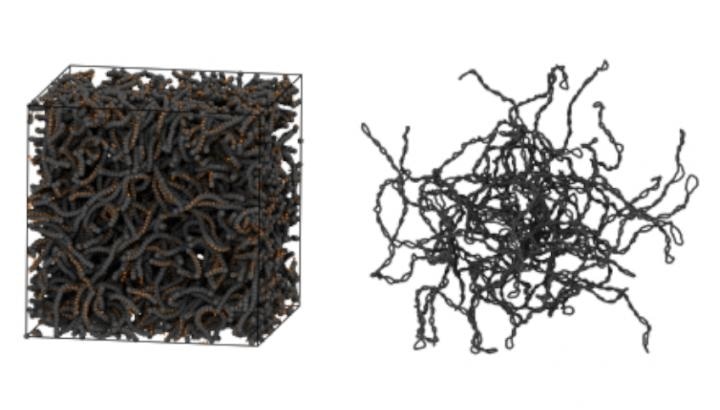Reviewed by Dan Hutchins, M.PhilMay 31 2021
DNA is usually idealized as the “molecule of life,” but it is also a highly advanced polymer that can be used for cutting-edge materials. Apart from storing information, other interesting aspects of DNA are its topological and geometrical properties, like super-coiling and knotting.

On the left, a snapshot of the simulated system—a dense solution of a supercoiled plasmid. On the right, a more detailed view of the supercoiled fluid showing entanglements between the molecules. Image Credit: © Davide Michieletto, University of Edinburgh and Jan Smrek, University of Vienna.
DNA is indeed quite similar to a twisted telephone cord and is typically found coiled up within bacteria and other kinds of cells. It is even knotted in viruses.
Now, researchers from the University of Edinburgh, the University of San Diego, and the University of Vienna have teamed up to harness the properties of DNA to design “topologically tunable” DNA-based soft materials and complex fluids that have promising applications in tissue regeneration and drug delivery. The study has been published in the Science Advances journal.
The double-helical shape of DNA is quite popular and holds immense implications for its behavior. A linear DNA molecule, that is, a DNA molecule that has two ends, can twist and turn freely. On the other hand, combining both ends to create a DNA circle requires that any under or over twisting of the double-helix stays “topologically locked,” that is, the additional twist cannot be eliminated without splicing the molecule.
Under or over twists have fascinating outcomes for how the molecules of DNA assemble in space—specifically, these molecules coil and buckle onto themselves similar to an old telephone cord into the supposed supercoiled conformations as shown in the above image.
DNA buckling relieves stress from the under or over twisting, and thus reduces the overall molecular size. Due to this reason, it has been assumed that supercoiling is a natural mechanism that is used by cells to package their genome into very small spaces.
Although the smaller size naturally makes DNA molecules diffuse more quickly in a solution, for example, through gel pores or in water due to the lower drag, this well-known behavior does not take place when several DNA molecules are entangled and packed, similar to spaghetti in a bowl.
We have performed large-scale computer simulations of dense solutions of DNA molecules with different degree of supercoiling and found several surprising results. In contrast to the dilute case, the more super-coiled the DNA rings, the larger their size.”
Jan Smrek, Study First Author, University of Vienna
Since the molecules had to avoid one another, their shapes tend to adopt robustly branched and asymmetric conformations that take up more volume when compared to their non-supercoiled counterparts. But interestingly and contrary to expectations, “the larger DNA molecules still yield faster diffusion.” The faster diffusion implies that the viscosity of the solution is lower.
Plasmids are supercoiled DNA molecules that occur naturally in bacteria. In vivo, cells have unique proteins, known as topoisomerase, that can decrease the quantity of supercoiling in plasmids.
Thanks to these proteins—which can be purified and used in the lab—we are able to control the extent of supercoiling in entangled DNA plasmids and study their dynamics using fluorescent dyes. We were amazed to discover that, indeed, DNA plasmids that were treated with topoisomerase, and hence with low supercoiling, are slower than their highly supercoiled counterparts.”
Rae Robertson Anderson, University of San Diego.
Anderson headed the experiments at the University of San Diego.
To describe the unexpected faster dynamics, the researchers employed large-scale simulations on supercomputers to measure the extent of the entanglement of the molecules in solutions.
Although it is known that a ring-shaped polymer—quite analogous to a circular DNA plasmid—can be threaded by one more ring, which means that the latter can penetrate the eye of the former, it was vague how this form of entanglement has an impact on the movement of supercoiled DNA.
Due to the simulations, the researchers were able to observe that a high level of supercoiling reduces the penetrable region of every molecule that results, in turn, in fewer threadings between the plasmids and eventually yields a lower-viscosity solution.
However, the plasmids could still enclose each other and limit the movement of one another without threading. But the supercoiling tends to stiffen the conformations and thus makes them less prone to bend and entwine closely, which also decreases this kind of entanglement.
Not only did we find these novel effects in simulations, but we also demonstrated these trends experimentally and developed a theory describing them quantitatively. By changing the supercoiling we can tune the viscosity of these complex fluids at will. We now understand much better the connection between the adaptive geometry of the molecules and the resulting material properties.”
Davide Michieletto, University of Edinburgh
“This is not only exciting from the fundamental perspective, but also promises useful applications. Using dedicated enzymes, such as the topoisomerase, one can design switchable DNA-based soft materials with tunable properties,” concluded Michieletto.
Source:
Journal reference:
Smrek, J., et al. (2021) Topological tuning of DNA mobility in entangled solutions of supercoiled plasmids. Science Advances. doi.org/10.1126/sciadv.abf9260.